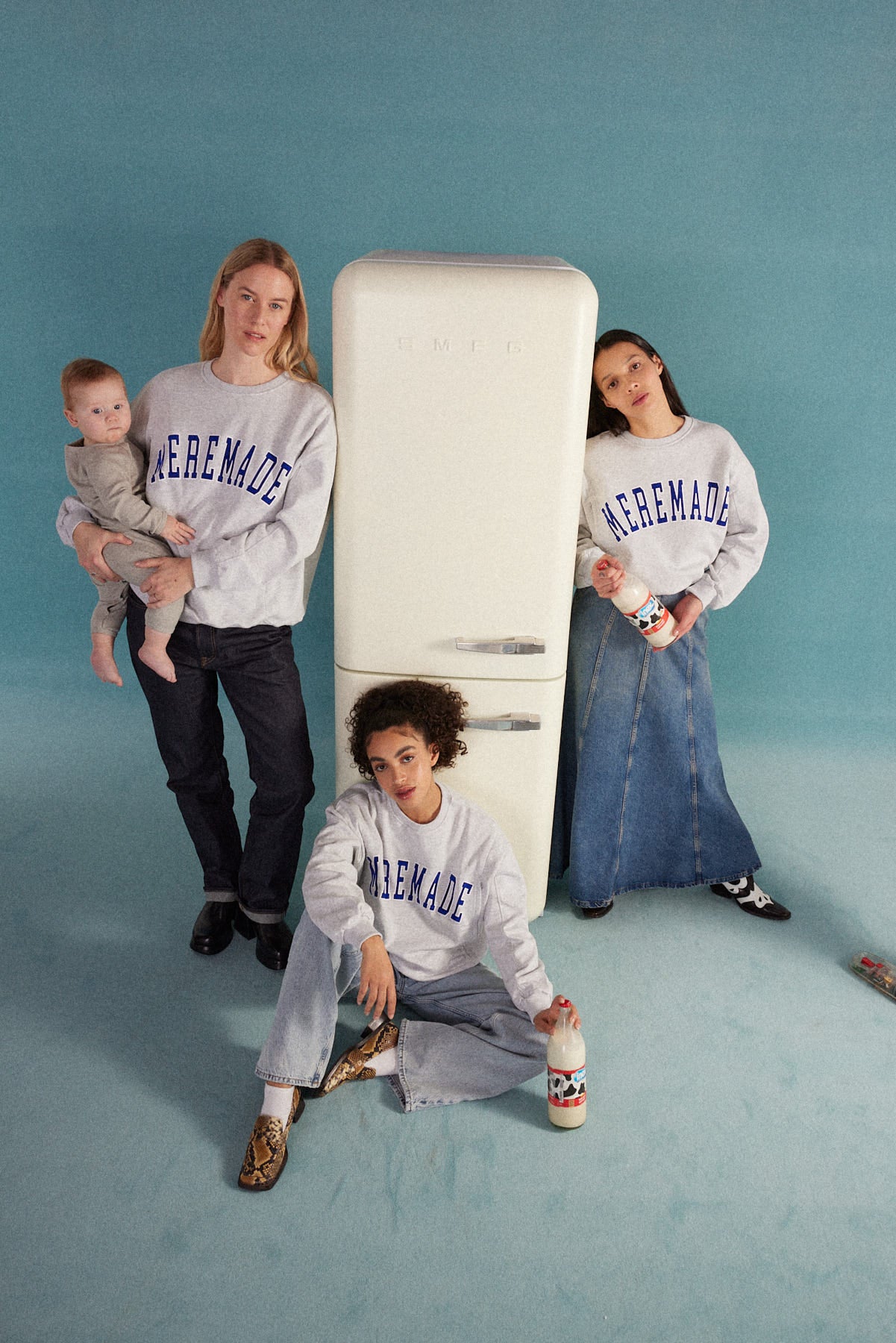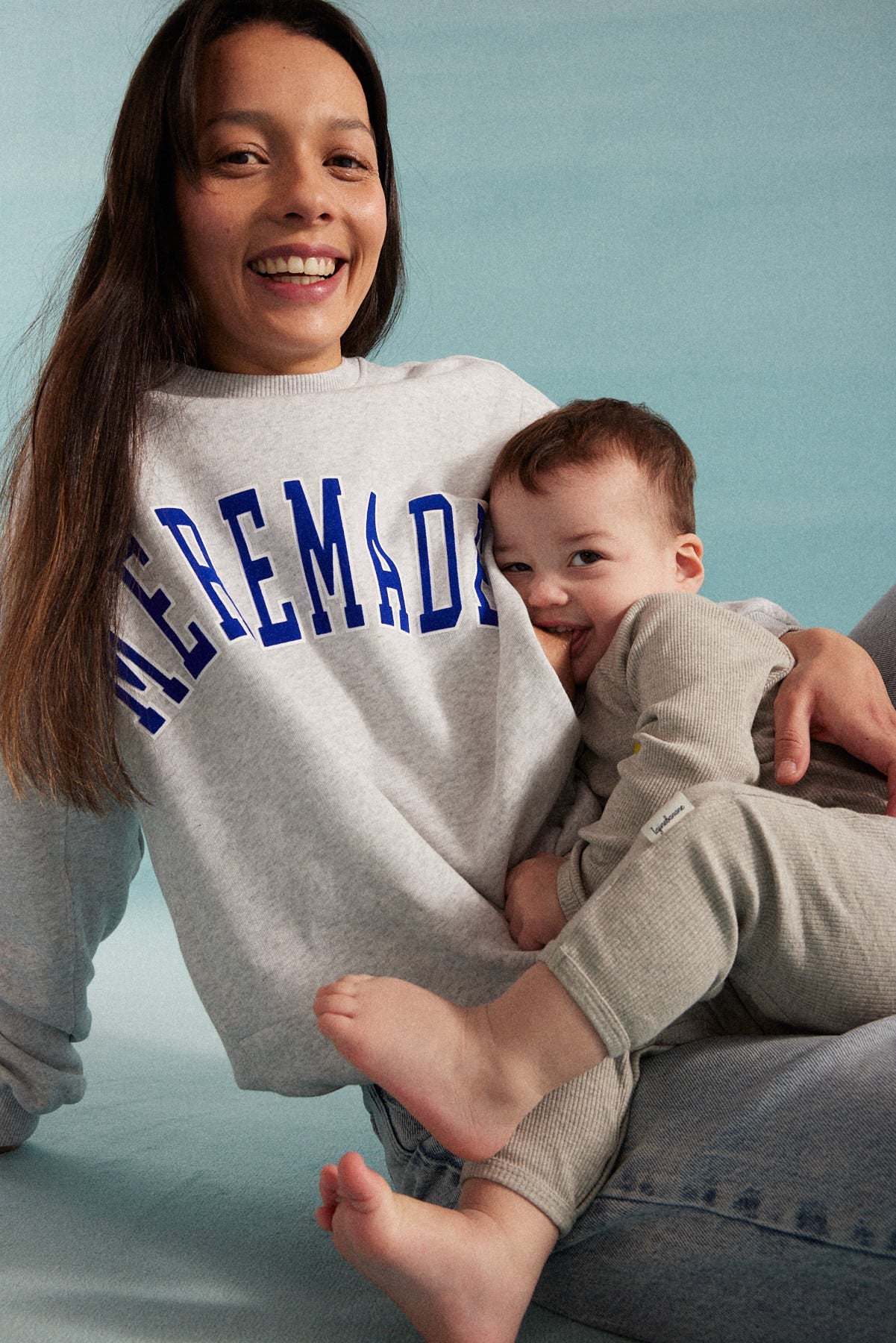
LA DIVERSIFICATION MENÉE PAR L'ENFANT
L'alimentation autonome
“Purée & DME c’est OK ! So let me introduce you to l’alimentation la plus autonome possible for ton baby” C’est ainsi que s’ouvre le compte de @daroniefoodclub et la très drôle Manon, orthophoniste à Marseille. Elle est venue animer un atelier DME à la Mom Sweet Home il y a quelques semaines, suivie de Marion Guérin, accompagnatrice en diversification alimentaire… enfin quelques mois, mais on est tellement en retard qu’on fait comme si c’était pas le cas.
LA DME, C’EST QUOI ?
C’est un moment, dans la première année du bébé, où vous vous dites : ok mon.ma grand.e, tu as 6 mois (ou plus) et toutes tes dents (enfin bientôt)... C’est l’heure de t’apprendre à manger tout.e seul.e (plus ou moins). 👶🏼
La diversification menée par l’enfant, aussi appelée alimentation autonome, est une approche qui privilégie la découverte des aliments solides par l’enfant, plutôt que les purées et compotes données à la cuillère par les parents (sans l’abandonner complètement non plus).
Pour votre enfant, c’est une sacrée expérience : jusque-là habitué.e au lait, qui restera la base de son alimentation la première année, iel découvre de nouvelles textures, de nouveaux goûts, de nouvelles odeurs...
Pour vous, c’est aussi une aventure, qui implique d’avoir confiance en ses capacités à se débrouiller tout.e seul.e… Et ne pas avoir peur d’en avoir partout par terre... 🧹
▹ Comment je sais que mon bébé est prêt ?
Si l’alimentation autonome se met habituellement en place autour de 5-6 mois, il est important de rappeler que l’âge ne doit pas être l’indicateur principal.
Si vous voulez savoir si votre bébé est prêt à manger tout seul, plusieurs acquis sont à vérifier :
‣ Maintenir la position assise : sans avoir à se tenir droit comme un I, votre bébé doit pouvoir tenir assis tout seul ou avec un minimum d’aide sur sa chaise haute, sans sangles autour des épaules. Le but est de vérifier qu’il.elle est suffisamment tonique, musculairement parlant, pour aborder la découverte alimentaire.
‣ Agripper les objets et les amener à la bouche : quand la paume de la main se referme sur l’objet volontairement attrapé, et qu’iel l'amène facilement à sa bouche, c’est gagné !
‣ Montrer un intérêt pour la nourriture : pour cela, vous pouvez l’habituer dès le plus jeune âge en le.la mettant à table avec vous ou lorsque vous cuisinez... Si vous voyez qu’il.elle ouvre grand les yeux face à votre nourriture ou qu’il.elle bave, c’est bon signe !
Pour résumer, pour débuter la diversification menée par l’enfant, vous avez besoin :
‣ d’un bébé avec les mains propres 👌🏼
‣ d’un aliment à la taille et à la texture sécuritaire ⚠️
‣ d’une chaise haute (et d’une grande nappe au sol) 🧺
▹ Quel est votre rôle ?
Le meilleur moment n’est pas le même pour chaque parent ; il faut essayer. Julie Longy, consultante en lactation IBCLC partage ses recommandations :
‣ Assurez-vous que votre bébé ne soit pas trop fatigué et n'ait pas trop faim : le repas du midi est souvent le repas idéal pour débuter l’alimentation autonome.
‣ Offrez-lui 2 ou 3 aliments (sains et variés) par repas pour commencer, en petites quantités, sur un plateau face à lui.elle ou directement dans sa main.
‣ Donnez-lui du temps : les premiers repas peuvent durer une quarantaine de minutes (le temps de le.la laisser digérer, arriver à satiété…).
‣ Expliquez-lui ce qu’iel mange, les couleurs, les textures, les noms...
‣ N’hésitez pas à l’accompagner… ça ne sera pas 100% autonome dès le début et ce n’est pas grave ! Si votre bébé commence à se frustrer, offrez-lui du lait et/ou une sieste.
‣ En fin de repas, vérifiez si aucun aliment n’est resté coincé sur le palais ou dans les joues
‣ Soyez prêt.e à ce qu’il y en ai partout par terre !
▹ Avec quels aliments peut-on commencer la DME ?
Le but est de choisir des aliments qui s'adaptent au développement de son bébé et de ce qu’il sait faire d’un point de vue moteur (attraper, mastiquer…), pour qu’il soit en réussite.
‣ Les textures fondantes
Les aliments crus et croquants sont évidemment à éviter. Il faut privilégier les textures fondantes. La mastication est un processus que l’on met du temps à acquérir, considéré comme mature entre 4 et 6 ans.
Pour vérifier que la texture est la bonne, en mettant l’aliment en bouche : si il s’écrase facilement par pression de la langue sur le palais, c’est parfait (cela permet aussi de vérifier la température)
‣ Une taille adaptée
Le format bâtonnet est idéal pour débuter la DME. Il doit rentrer dans la paume de sa main pour être bien maintenu et ne doit pas être plus petit que le diamètre d’un doigt adulte, pour éviter les risques d’étouffement.
Dans la liste des aliments parfaits pour commencer DME, il y a notamment :
‣ La banane. 🍌
‣ L’avocat 🥑
‣ La pastèque et le melon. 🍉
‣ Les légumes verts cuits vapeur (brocolis, courgettes…). 🥦
‣ Des quartiers de pêche bien mûres. 🍑
‣ Le blanc de poulet bien cuit. 🍗
‣ La patate douce ou carotte bien cuite. 🥕
‣ Les pâtes bien cuites. 🍝
Les aliments à éviter ou à détourner jusqu’à 4-6 ans :
‣ Pour éviter le risque d’étouffement : noix, cacahuètes 🥜, raisins entiers ou secs 🍇, graines, morceaux de carottes ou pommes crues 🍏
‣ Pour éviter les risques nauséeux : feuilles de laitue crue 🥬, mie de pain 🍞, purée d’oléagineux tartinés en couche épaisse 🌰
‣ Pour éviter les risques bactériologiques : le miel jusqu’à 1 an 🍯, les viandes et poissons crus 🍣, les oeufs et lait crus 🥛
‣ Pour la teneur en sucre / gras / sel : le chocolat 🍫, les fast food 🍔 ou jus de fruit... 🧃
▹ Les allergènes : à vérifier petit à peti
En France, 14 allergènes alimentaires sont reconnus (œufs, lait de vache, arachides, gluten…). Pour réduire les risques d’allergie futures, il est recommandé de les introduire avant les 12 mois de votre enfant.
La meilleure façon de “valider” un allergène, c’est à dire de vérifier que votre enfant n’est pas réactif, c’est de suivre le calendrier suivant :
‣ Introduire un premier allergène en petite quantité (moitié d’un ongle minimum), 3 jours consécutifs
‣ Faire une pause pendant 2 jours (sans allergènes) pour vérifier qu’il n’y a pas de signes cutanés, digestifs ou respiratoires
Si aucun signe n’est constaté, c’est qu’iel n’y est pas allergique. Vous pouvez passer à l’allergène suivant.
À la moindre question ou au moindre doute, consultez un pédiatre ou un allergologue.
▹ Des nutriments divers et variés
Il est important de donner dès le début à votre bébé une alimentation variée, en veillant aux qualités nutritionnelles de chaque aliment. Un repas complet (une fois que la DME est bien mise en place), devrait inclure des aliments de chaque groupe, dont :
‣ un (ou des) légume(s) 🥦
‣ un féculent (pain, pâtes, pomme de terre, etc.) 🥖
‣ de la viande, du poisson, des oeufs, des légumineuses, etc. (notamment pour l'apport en fer) 🍗
‣ un produit laitier 🥛
‣ un fruit 🍌
‣ une matière grasse 🧈
‣ LE FER : un nutriment au premier plan
Entre 0 et 6 mois, votre enfant utilise ses réserves en fer pour sa croissance. Sauf que d’un coup, à partir de 6/7mois, ses réserves sont épuisées et ses besoins sont exponentiels. Pour éviter une carence en fer (majorée à partir de 6 mois), vous pouvez donc prioriser dès le début des protéines animales (poisson bien cuit, viandes ou oeufs). Astuce : Pour maximiser l’absorption du fer, vous pouvez ajouter une source de vitamine C au repas, un fruit par exemple.
‣ PROTÉINES et LIPIDES : des forces pour grandir
Les enfants plus jeunes ont besoin de plus de gras et de plus de protéines que les enfants plus âgés, car les besoins caloriques pour leur pic de croissance sont plus importants. (besoins caloriques plus hauts). Les Oméga 3 sont également importants pour le cerveau.
La cuisson à la vapeur est celle qui préserve le mieux les nutriments de vos aliments. Si vous n’avez pas le temps de faire des courses, privilégiez les légumes surgelés plutôt que ceux en conserve.
Faites confiance à votre.vos enfants : ils mangent en fonction de leurs besoins. Quand vous leur laissez le choix parmi différents aliments, ils consommeront par exemple plus de lipides quand ils sont en poussées de croissance, plus de sucres quand ils récupèrent d’une maladie ou des lipides quand il fait froid.
▹ Et le réflexe nauséeux ?
Une des principales craintes des parents - et elle est normale - au démarrage de la DME, c’est l’étouffement. Si vous suivez les bonnes recommandations concernant la taille/texture de l’aliment et que vous ne laissez pas votre enfant manger tout seul (sans surveillance), tout se passera bien !
Si vous observez votre bébé avoir des GAG (réflexes nauséeux), ne paniquez pas ! Réflexe nauséeux et étouffement sont 2 mécanismes complètements différents :
‣ l’étouffement (dans la gorge) est une situation d’urgence, qui indique que les voies respiratoires sont obstruées. Les signes d’étouffement peuvent être des râles, des pleurs ou la main à la gorge… Pour vous rassurer, renseignez-vous sur les gestes de premiers secours à effectuer en cas de fausse route et/ou, si cela arrive, appelez le 15.
‣ le réflexe nauséeux (dans la bouche) est, au contraire, sécuritaire et temporaire. Il permet à l’enfant de protéger ses voies respiratoires de l’étouffement lorsqu’il met un aliment trop loin dans sa bouche. S'il arrive, ne paniquez pas, rassurez votre bébé, tout va bien.
Comment les aider à faire reculer ce réflexe ?
‣ Laissez-les mettre les doigts dans la bouche et se désensibiliser
‣ Choisissez des jouets de dentition qui ont des pics
‣ Désensibiliser leur palais en glissant votre petit doigt dessus, petit à petit.
Bon appétit la Mif ! 👋🏼
Si vous avez aimé cet article n'hésitez pas à le partager autour de vous!










